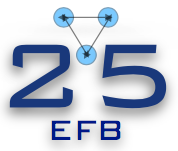Speaker
Description
Pionless effective field theory (EFT) represents a highly convenient tool to describe the nuclear interaction at low energies. This theory has been used at its leading order (LO) to study various nuclear systems, however, it has failed to give bound nuclei with A > 4 [1,2,3,4].
In our recent study [5] we adressed low-energy $p$-wave $n^3\text{H}$ scattering and the position of the $^4 \text{H}$($J^\pi = 1^-$) resonance using the LO pionless EFT. Results were obtained using three different numerical techniques: confining the system in a harmonic oscillator trap, solving the Faddeev-Yakubovsky equations in configuration space, and using an effective two-body cluster approach. Inspecting residual momentum-cutoff variation between 1 and 10 fm$^{-1}$, our numerical results strongly suggest a cutoff-stable/RG-invariant resonance in $^4$H. The stabilization of a resonant state in a few-fermion system through contact interactions has a significant consequence for the powercounting of pionless EFT. It suggests the appearance of similar continuum states also in larger nuclei, like $^6$Li, $^7$Li, or $^{16}$O, in which the theory at LO does not predict bound states. Such poles could then be moved to the correct physical position by the perturbative insertion of sub-leading orders, thus resolving the discrepancy between experimental data and pionless EFT.
References :
[1] I. Stetcu, B.R. Barrett, U. van Kolck, Phys. Lett. B 653, 358 (2007).
[2] L. Contessi, A. Lovato, F. Pederiva, A. Roggero, J. Kirscher, U. van Kolck, Phys. Let. B 772, 839 (2017).
[3] W. G. Dawkins, J. Carlson, U. van Kolck, and A. Gezerlis, Phys. Rev. Lett. 124, 143402 (2020).
[4] M. Schäfer, L. Contessi, J. Kirscher, and J. Mares, Phys. Let. B 816, 136194 (2021).
[5] L. Contessi, M. Schäfer, J. Kirscher, R. Lazauskas, and J. Carbonell, Phys. Let. B 840, 137840 (2023).

